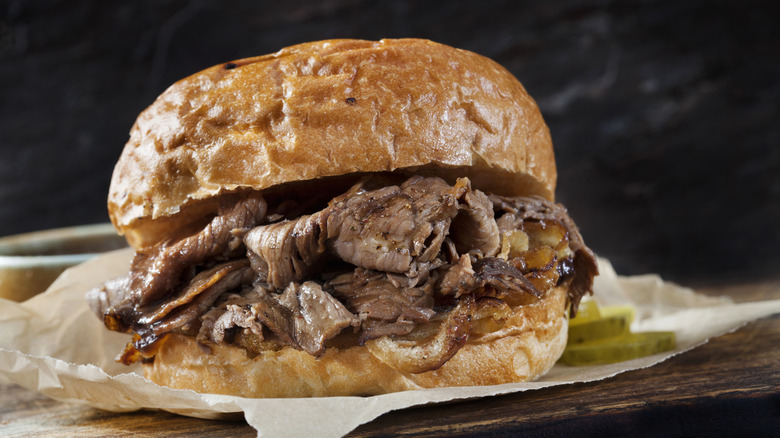How The Sandwich Gained And Lost Its Scandalous Reputation
Though people have been stuffing delicious things between pieces of bread for millennia, the term "sandwich" didn't come into vogue until the 1760s in England. The story goes that while attending a late-night card game, John Montagu, the 4th Earl of Sandwich, requested that his meat be placed between two slices of bread so he could eat without getting his cards greasy. However, this was hardly the first time a gentleman had asked for cold meat and bread during a card game, as these were common fare at men's gatherings.
In Bee Wilson's book "Sandwich: A Global History," Wilson suggests that Montagu's request was revolutionary not due to the food he was requesting, but for how he requested it. While small meals of bread, meat, and sometimes cheese were commonplace in the 18th century, they were usually served more like a charcuterie board. According to Wilson, Montagu may have been the first to request these ingredients be layered together, rather than assembling the bites himself.
Wilson also theorizes that this innovation led to other men requesting "the same as Sandwich," which resulted in the term "sandwich" coming into common usage. However, these original sandwiches were a far cry from present-day selections like pesto caprese paninis or a classic grilled cheese. In general, Montagu and his cronies would have enjoyed much simpler fare — cold beef sandwiched between two slices of bread was most common, though some may have added an indulgent slice of cheese or dash of mustard.
Sandwiches' association with vice and greed
Contrary to legend, some historians believe that Montagu likely asked for this simple, portable meal while hard at work at his desk rather than at a 24-hour gaming session. Though Montagu did play cards and gamble like most gentlemen of his day, he was also passionate about his work as a politician. Given this, it's unlikely he would have been so irresponsible with his time or money as to gamble for 24 hours straight. So, where did these rumors originate?
It turns out the original legend comes from French writer Pierre-Jean Grosley's account of his time in England, recorded in his work "A Tour of London." Though historians believe the tale to be embellished, it demonstrates that sandwiches were associated with gambling and men's pursuits during Montagu's lifetime. Gambling was also a popular source of entertainment in the 18th century, likely owing to innovations in industry and trade that allowed working-class men to rise through society's ranks.
Though women also occasionally gambled, it was in the privacy of someone's home, as gaming halls were exclusively for me. These seedy, smokey spaces were seen as dens of vice, and sometimes financial ruin. In them, men could — and often did — lose fortunes and plunge their families into poverty. Sandwiches being frequently served in these places meant they were also associated with men's vices and irresponsible behavior.
Saving the sandwich from an unseemly reputation
Despite its inauspicious beginning, the sandwich soon gained popularity outside of men's gatherings for its portability and versatility. Social gatherings among the upper crust often ended with a light supper, and sandwiches soon became a supper-table staple. Not long after that, George III and Queen Charlotte sealed the sandwich's place in respectable society by taking them on outings to feed their 15 children on the go.
By this time, the sandwich had also evolved from a mere layer of cold beef or ham between two pieces of bread into something a bit more refined. House cooks were encouraged to use flavors and ingredients worthy of refined social gatherings. This new trend resulted in delicate tea sandwiches filled with thinly sliced cucumber, cress, and fresh butter or savory cheese and pickles.
Simultaneously, sandwiches were also gaining popularity among the working class. Men employed in mills and factories often worked too far from home to join their families for a midday meal. Instead, they'd carry sandwiches with them to work to sustain them during the day. From there, the sandwich gained popularity throughout Europe and into North America, becoming a staple in both homes and restaurants. Rescued from its notorious beginnings, the sandwich is now an inextricable part of modern culture — and a tasty one, at that.


